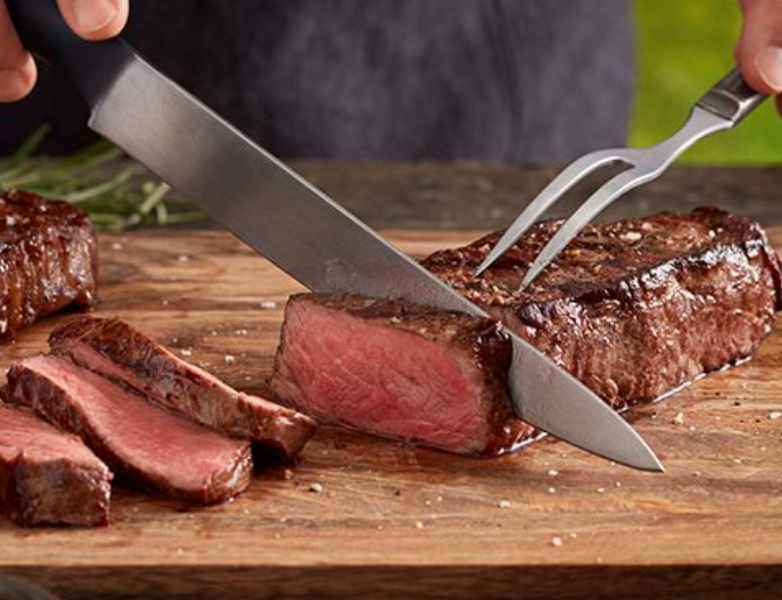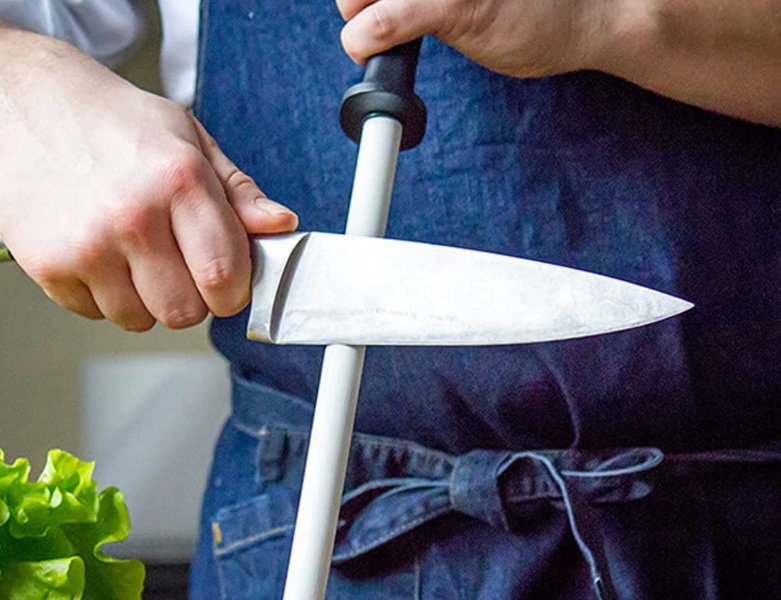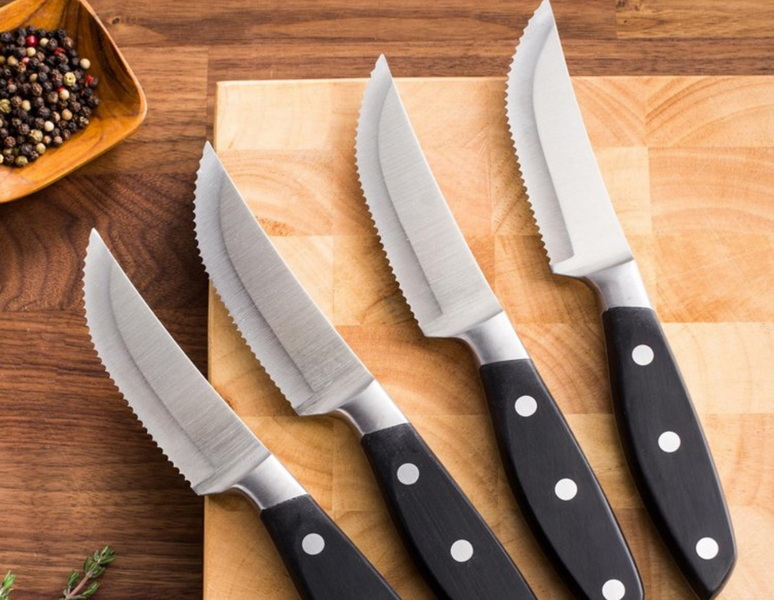- All
- Product Name
- Product Keyword
- Product Model
- Product Summary
- Product Description
- Multi Field Search
Views: 222 Author: Ann Publish Time: 2025-10-29 Origin: Site











Content Menu
● Introduction to Steak Knife Basics
● Understanding Blade Materials
● Maintaining Rust and Stains Prevention
● Basic Knife Sharpening Principles
>> 1) Honing (maintenance between sharpenings)
>> 2) Hand-Finished Sharpening (for best precision)
>> 3) Guided Sharpening Systems
>> 4) Professional Sharpening Services
● Maintenance Routine for Steady Performance
● Storage Solutions and Safety
● Branding and OEM Considerations for Steak Knife Maintenance Content
● Practical Demonstrations: Using Knife Kits and Accessories
● Testing Edge Sharpness at Home
● Choosing The Right Strategy For Your Market
● FAQ
>> 1) Q: How often should I sharpen a steak knife?
>> 2) Q: Can I sharpen steak knives on a regular kitchen whetstone?
>> 3) Q: What blade material is best for low maintenance?
>> 4) Q: Should I soak water stones before sharpening?
>> 5) Q: How do I store steak knives to prevent damage?
A steak knife is a dedicated cutting tool designed to slice cooked beef with clean, straight cuts. The typical steak knife features a thinner blade than a chef knife, a comfortable handle, and a controlled edge geometry that aligns with the purpose of portioning cooked meat at the table or in the kitchen. The performance of a steak knife depends on blade material, edge geometry, and how well the knife is maintained over time.

- Stainless steel: Corrosion resistance, low maintenance, suitable for daily use.
- High-carbon stainless steel: Combines edge retention with corrosion resistance.
- Carbon steel: Exceptional edge retention, may require more care to prevent rust.
- Damascus or layered steels: Aesthetic appeal with strong performance, requires mindful maintenance.
Rust prevention is essential for longevity, especially in humid environments or coastal regions. A well-maintained steak knife remains visually appealing and performs predictably.
- Dry knives thoroughly after washing.
- Avoid soaking in water for extended periods.
- Store in a dry environment; use protective sheaths or knife blocks that promote airflow.
- Wipe exposed metal surfaces with a light oil (food-grade) if you live in humid areas.
- For carbon steel blades, consider a light coat of mineral oil to deter moisture between uses.
Edge geometry is a decisive factor in determining cutting performance and maintenance frequency. For steak knives, common bevel angles range from 15° to 20° per side, depending on blade design, material, and use-case. A properly sharpened steak knife should bite into meat with ease, producing clean slices without tearing.
- Edge angle: 15°-20° per side is typical for most kitchen steak knives.
- Micro-bevels: Some high-end blades benefit from a micro-bevel at the trailing edge to improve durability.
- Sharpness targets: The ideal blade should feel feather-light when slicing through muscle fibers yet maintain structural integrity under use.
- Tool: Honing rod (steel) or ceramic rod.
- Purpose: Realigns microscopic burrs after light use.
- Method: Hold knife at the correct angle and gently run the blade from heel to tip in a single smooth stroke on each side.
- Frequency: After every few uses or before professional service to maintain edge alignment.
- Tools: Whetstones (coarse, medium, fine), sharpening guide, water or oil as required by the stone.
Process:
- Soak or prepare the stone according to manufacturer instructions.
- Start with a coarse grit to repair chips or refresh a dull edge.
- Progress through medium to fine grits to refine the edge.
- Use even strokes, maintaining the correct angle throughout.
- Finish with a light stropping on a leather strop or felt strop to remove residual burr and finalize a polished edge.
- Practical tips: Keep your stones flat; rinse between grits to prevent clogging; maintain consistent pressure.
- Tools: Specialty guided sharpening systems that lock the blade at a fixed angle.
- Benefit: Consistent edge angle across both sides of the blade.
- Process: Follow the system's instructions, typically finishing with a fine stone and strop.
- Ideal for OEM programs: Provide a consistent consumer experience across SKUs.
- When to use: If blades are damaged, heavily nicked, or if you prefer a professional finish for a premium product line.
- Additional considerations: For OEM clients, offering certification or care cards after professional sharpening can reinforce trust.
- Using too high an angle, which reduces sharpening efficiency and edge feel.
- Improperly cleaning blades, leaving mineral deposits or rust-prone residues.
- Neglecting to dry blades fully after washing, especially in coastal or humid environments.
- Over-sharpening or sharpening inconsistently, leading to uneven edges.
- Storing a wet knife, which accelerates corrosion on vulnerable blade materials.
A structured maintenance routine helps sustain optimal performance and longevity of steak knives across professional kitchens and home use.
Daily/Weekly:
- Clean and dry after each use.
- Lightly oil blades to prevent rust on carbon steel variants.
- Honing after every few uses or before each service in a professional setting.
- Inspect for minor nicks and address promptly to avoid edge propagation.
Monthly:
- Inspect blades for chips or dullness.
- Re-sharpen as needed, especially if the edge has become rounded or nicked.
- Inspect handles for looseness and tighten or repair as needed.
Seasonal:
- Check handles for structural integrity; consider re-assembly if necessary.
- Inspect packaging and storage to ensure no moisture buildup and to maintain presentation quality.

- Knife blocks with proper ventilation to reduce moisture buildup.
- Magnetic bars or magnetic racks with blade guards.
- Blade guards or sheath protectors for transport and storage.
- Knife rolls with individual slots to prevent blade contact and ensure safe transport.
- Drawer inserts with separators to avoid blade-to-blade contact.
Safety tips:
- Always cut away from your body and keep fingers clear of the cutting edge.
- Use a stable cutting surface.
- When handing a knife, offer the blade by the handle, keeping the edge away from others.
- Keep blades out of reach of children and store securely when not in use.
- Use clear, actionable steps that align with your product lines, including blade materials you offer (stainless, high-carbon stainless, Damascus).
- Include product-specific care recommendations, such as whether a particular handle material requires special maintenance.
- Showcase your OEM capabilities by including diagrams and product-specific maintenance tips for different SKUs.
- Produce downloadable care sheets or care cards that can accompany each knife set.
- Provide multilingual versions to support global customers.
- Offer warranty-backed care guidance to build trust with distributors and end customers.
- Honing rods: Demonstrate how to use indicators for angle consistency.
- Whetstones: Show water or oil preparation, oiling the stone, and proper stroking technique.
- Leather strops: Display polishing actions and the final test cut on a tomato or a piece of steak.
- Maintenance kits: Include oil, cloths, protective sheaths, and spare guides to illustrate a complete OEM offering.
- Cut test: A clean, uninterrupted slice through a tomato skin or a piece of meat.
- Paper test: A thin, light paper slice to observe minimal tearing.
- Food-grade polymer test: A precise cut through a food-safe polymer to evaluate edge stability.
- Advanced tests: A drop test of a mock kitchen scenario to observe edge behavior under minor impacts (for premium product lines).
- For mass-market home users, emphasize easy maintenance, rust resistance, and affordable edge care.
- For premium segments, highlight edge retention, luxury materials, and professional sharpening workflows.
- For restaurant and hospitality buyers, emphasize rapid, repeatable results, safety, and durable edge geometry.
- Regional considerations: North America may prioritize easy-care and safety features; Europe often values premium materials and aesthetics; Asia-Pacific may seek a balance of performance and value, while the Middle East may emphasize durability under high heat and robust corrosion resistance.
Maintaining and sharpening steak knives like a pro combines proper materials knowledge, sharpening technique, routine upkeep, and thoughtful storage. By adopting consistent honing, selective sharpening when needed, and careful care for blade materials, you can sustain optimal cutting performance and extend the life of your steak knives. For OEM brands, providing clear maintenance guidance and high-quality care materials strengthens customer trust and differentiates your product line in international markets. A well-crafted maintenance program also supports brand reputation, reduces post-sale issues, and enhances retailer confidence in premium product lines.

A: Regular honing keeps the edge aligned, while periodic sharpening (every few months for regular home use, more often in commercial settings) refreshes the edge by removing material to restore a true cut.
A: Yes, with the correct angle and careful technique. Start with a coarse stone if the edge is dull or nicked, then progress to finer grits and finish with a strop.
A: Stainless steel with good corrosion resistance is typically the easiest to maintain for daily home use.
A: Follow the manufacturer's instructions for your specific stone. Some stones require soaking; others are splash-and-go or require only surface wetting.
A: Use blade guards, a magnetic strip with protective spacers, or a dedicated knife block with good airflow and moisture control.
The Ultimate Professional Knives for Halal Butchery in Middle Eastern Kitchens
Chef Knife Size Guide: Choosing Between 6″, 8″, 10″, And 12″
Custom Knife Handles: How To Design A Chef Knife That Fits Your Hand Perfectly
Chef Knife Surface Treatments Guide: From Polished Migaki To Damascus Patterns
Inside Our Professional Knife Sample Room: Quality You Can See
Universal Knife Block Buying Guide: Modern Acrylic & ABS Knife Holders for Professional Kitchens
Universal Knife Block: The Complete Guide To Modern, Hygienic Knife Storage
The Complete Guide To Red Handle Knife Sets: Style Meets Functionality in The Kitchen
Professional Knives for Halal Butchery And Middle Eastern Cuisine